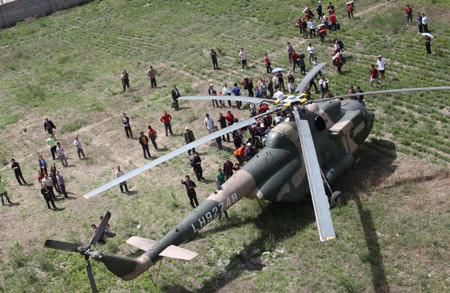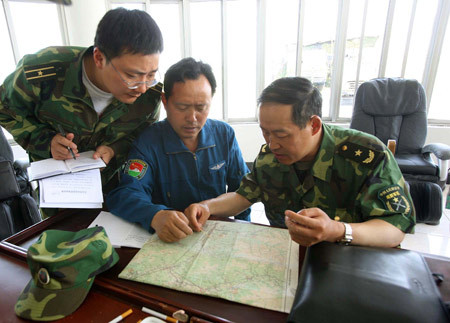More than 4,000 military personnel Sunday were searching for survivors of a military transport helicopter that crashed with five relief workers and 14 injured quake survivors near Yingxiu township in Sichuan Province on Saturday.
The Mi-171 helicopter was returning after carrying a team of epidemic prevention experts to Lixian county and picking up the injured when it encountered strong turbulence and fog, and crashed at 2:56 pm, military sources said.

Photo taken on May 16, 2008 shows a Mi-171 transport helicopter is ready to transport people from quake-hit Maoxian County, southwest China's Sichuan Province, to a safe place.
President Hu Jintao, who is overseeing quake relief operations in neighboring Shaanxi province, ordered local authorities to conduct a thorough search for the survivors.
On Saturday, a day before International Children's Day, Hu visited a temporary school in quake-hit Hanzhong, Shaanxi province, and spent time with the children there.
He told vice-chairman of the Central Military Commission Guo Boxiong to fly to the frontline to direct the operation.
Guo has already reached Chengdu, capital of Sichuan province, and held a meeting Sunday morning, instructing rescue workers how to conduct the operation.
But the rescue teams have not been able to identify the exact spot of the crash. That's why it's difficult to say if there are any survivors.

Chinese military officers discuss a plan for the searching of the crashed helicopter at Fenghuangshan airport in Chengdu, capital of southwest China's Sichuan Province, June 1, 2008.
Quake lake
The project to drain out water from the Tangjiashan quake lake in Beichuan county was completed at 10 pm on Saturday, a water resources official said.
About 135,500 cu m of mud and rocks were removed from the quake lake, leaving a 475-m-long channel up to 10-m wide in the giant dam created by landslides, said Liu Ning, chief engineer of the Ministry of Water Resources and deputy director of the diversion project.
The lake's 200 million cu m of water threatened to break the dam flood the villages, towns and counties downstream, bringing more misery to those hot by the quake.
The rising water in the lake will flow over the blockage and continue its journey through the manmade canal, and that can happen as early as tomorrow, an expert team said.
The earlier plan to blow off the blockage with explosives was abandoned because the diversion channel was completed on time, Liu said.
Most of the more than 600 armed policemen working round the clock for nearly one week to break the lake's dam had left Tangjiashan, officials said.
Soldiers had carried more than 10 tons of dynamite to the site, trekking for hours on the mountains. They had to carry them back. Also sent back were garbage and surplus fuel to prevent environmental pollution.
A total of 197,477 people were evacuated to safer places till 8 am on Saturday in line with an emergency plan, said a local relief official.
Tan Li, Party chief of Mianyang and head of Mianyang city quake control and relief headquarters, had reiterated on Friday that 1.3 million people living downstream had to be evacuated to higher grounds demarcated by the government.
On Saturday night, downtown Mianyang city appeared deserted, with shops closed and several streets cordoned off. Sandbags had been stacked one upon another in front of the doors of houses and buildings along the projected flood path to prevent water from getting in.
Residents still living in the city were put through evacuation drills last week and were told that flood warnings will be communicated through signal shots and sirens.
The May 12 quake created 34 quake lakes, out of which 28 threaten to burst their banks and drown human settlements downstream.
Hu Yun, deputy director of the Sichuan provincial water resources department, said the threat posed by quake lakes would be over by June 10.